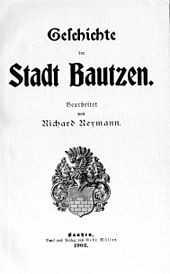Richard Reymann
Friedrich Wilhelm Richard Reymann (born December 13, 1840 in Budissin (today Bautzen ), † February 13, 1913 there ) was a German nail smith , self-taught and city historian. In 1902 his book History of the City of Bautzen was published , which is still an important source of the city's history today.
Life
Richard Reymann was born as the youngest of eleven children in Bautzen, Fleischergasse 23, in 1840. Father was Johann Immanuel Reymann (1796–1871), senior elder of the nail smiths guild. After the death of the mother Christiane Henriette geb. Meyer (* 1800) on May 3, 1845, the father married Henriette Christiane nee in October of the same year. Müller, daughter of a blacksmith at the ironworks in Creba . From this marriage there were another seven children.
education and profession
Reymann attended the orphanage school in Bautzen from 1847 to 1855. Following his wish to become a teacher, he took an entrance exam at the local teachers' college in 1855. Despite passing the exam, he was not accepted into the seminar due to his short-sightedness. When the dream of a copyist also failed, he finally got into his father's trade.
Richard Reymann was accepted as the last apprentice in the Bautzen nail smithy in 1856.
After his father's death in 1871, he was the last of his guild in Bautzen to give up nailing.
He now earned his living by wrapping cigars and as a nurse, among other things. He later ran a cutlery shop with his wife.
When, in 1893, the city council of Bautzen advertised the position of administrator of the city's tariff defeat at the private freight station, Reymann successfully applied. He carried out this activity until his death.
plant
Richard Reymann, whose interest in local history was aroused during his school days, spent his life studying the Bautzen council files and the old handwritten chronicles. He often sat late into the night and made excerpts for his town's history.
In 1902 he was able to complete his life's work on the "History of the City of Bautzen". He himself took care of the publication of the book, which appeared that same year.
When Reymann presented his chronicle to the Society for Anthropology and Prehistory in 1902, it received little recognition. The mostly missing sources were criticized. Reymann was sorely disappointed by the criticism.
Family and personal life
Richard Reymann married Ernestine Wilhelmine born on December 27, 1863. Sagittarius († 1929).
The couple had four children, Friedrich Wilhelm Richard (born February 27, 1863), the twins Heinrich Otto and Karl Bernhard (born May 26, 1865; Karl Bernhard died in the same year) and their daughter Clara Selma (born November 14, 1866 ).
Richard Reymann was a loner. His small circle of friends included personalities such as the local and family history researcher glazier Richard Wilhelm, his cousin Felix Wilhelm , who also publishes on urban history, and the bookseller and founder of the Bautzen antiquities collection, Oskar Roesger .
Richard Reymann died in 1913 at the age of 72 as a result of chronic asthma. He was buried in the historical part of the diving cemetery, near his friend Oskar Roesger, who died in 1910. Reymann's grave monument is no longer there; a memorial stone erected by the city of Bautzen and its citizens in 2002 commemorates its place.
In 1935 the city administration named the route from the Mühltor to the Burghof in Reymann.
literature
- Felix Wilhelm : Richard Reymann: the author of the history of the city of Bautzen. 1935, wilhelm-bautzen.de (PDF; 18 kB)
- Eberhard Schmitt: From the life of Richard Reymann . Preface to the reprint edition: Richard Reymann: History of the City of Bautzen . [Repr. d. Ed. Bautzen 1902] Lausitzer Druckhaus, Bautzen 1990, archive.org
Web links
Individual evidence
- ↑ Presumably, discrepancies between the father and the administrative bodies were the reason for not being accepted. Source: Schmitt, preface p. 6
| personal data | |
|---|---|
| SURNAME | Reymann, Richard |
| ALTERNATIVE NAMES | Reymann, Friedrich Wilhelm Richard (full name) |
| BRIEF DESCRIPTION | German city historian, autodidact and nail smith |
| DATE OF BIRTH | December 13, 1840 |
| PLACE OF BIRTH | Budissin (Bautzen) |
| DATE OF DEATH | February 13, 1913 |
| Place of death | Bautzen |

